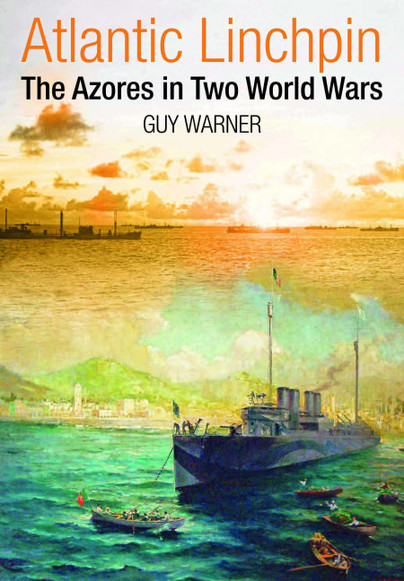Author Guest Post: Guy Warner
Holiday Destination – the Azores by Guy Warner
The Azores first came to prominence in the 15th century when the uninhabited isles were colonised by Portuguese and Flemish settlers. The harbors’ on the major islands assumed a vital role in replenishing ships on their way to the New World, Africa and the Orient on voyages of discovery, conquest and trade.
There are three distinct island groups spread over 400 miles (643km) of ocean. To the west are the tiny communities of Flores and Corvo. In the centre are grouped Faial, Pico, Sao Jorge, Graciosa and Terceira, while to the east are the main island of Sao Miguel and Santa Maria. Flores is 1100 miles (1770km) from Newfoundland and 2236 miles (3600km) from the East Coast of the USA, while from Santa Maria it is 869 miles (1400km) to Cabo da Roca in Portugal, the most westerly point of the European mainland.
Whaling became a necessary part of the islands’ economy at the beginning of the 19th century and then in the 1890s the first of several submarine cable stations was established on Faial, making the town of Horta into one of the major telegraphic communications relay centres of the world. Following the national revolution of April 25, 1974, the Portuguese Constitution granted the islands the status of Autonomous Region, with a regional Assembly and Government.
Today the mainstays of the economy are agriculture, fishing and a growing tourism sector.
For the visitor the main first impressions are of great natural beauty and tranquility. The islands are, as yet, unspoiled by the depredations of mass tourism. There are no high-rise hotels, casinos or crowded beaches. The roads are often bordered by hydrangeas and are a pleasure to drive along – dramatic volcanic landscapes contrasting with flower filled meadows and the discovery of quiet beaches tucked out of the way.
We have visited the Azores four times and stayed at a range of accommodation on eight of the islands – from the old cable company headquarters in the town of Horta on Faial, now a four star hotel, to restored manor houses on at Maia on Sao Miguel and in Angra de Herismo on Terceira; the very comfortable Hotel Camões and Hotel do Colégio in Ponta Delgada; on the beach in the Praia Marina on Terceira; a less satisfactory bed and breakfast on Flores, a really superior B&B on Corvo, the old airport hotel on Santa Maria, an excellent B&B on tranquil Graciosa and a very comfortable small hotel on Sao Jorge. Our room in Horta overlooked the harbour which was a major bonus, with the everchanging cloudscape and the light on the volcanic mound of Pico which sometimes seemed almost to give a 3D effect; the busy life on the water (freighters, ferries including the Lady of Mann from the Isle of Man Steamship Co, fishing boats of all types, yachts large and small, a Portugese naval frigate, local craft: all these provided much contemplative entertainment. At the excellent Solar de Lalem in Maia , we much enjoyed a daily ritual of a pot of Azorean tea on the terrace at 5pm. Corvo is a delightful place to spend a day or three. When you disembark from the aircraft, the loudest noise to be heard is the abundant birdsong. The new and modern guesthouse, the Comodoro, is first class. The island is only 4 miles (6.5 kilometres) long and 2.5 miles (4 kilometres) wide, with a total area of 10 square miles (17 square kilometres). From the only settlement, the little municipality of Vila do Corvo, population 400, with two taxis and one policeman, it is a fifteen minute drive up a very steep and twisting road to the Caldeirão, a scenically magnificent 300 meters deep, water filled crater – the remains of the former volcano. A gentle stroll down the road will take a couple of hours through hydrangea fringed pasture land with grazing cows and horses, fields of vegetables and maize, magnificent sea views and the possibility of spotting rare birds and butterflies. Back in the village, the excellent Restaurant O Caldeirão, just beside the picturesque windmills, is the best location for an evening meal. Another terrific place to eat is the airport café on Santa Maria, quite simply one the best small restaurants in which we have ever eaten. If you like fish, look no further than the Restaurante Sao Pedro in Ponta Delgada.
The food in the restaurants on every island was always good quality and reasonably priced, there were plenty of mini-markets, all of which served excellent coffee (a Portuguese speciality) and on each island there was usually at more than one large Modelo supermarket. Local produce to sample included wine, cheese, pinapples and tea (the only place in Europe in which it is grown). The indigenous soft drink is very good indeed – Kima – made from passionfruit.
Activities which we would recommend include whale watching (Norberto in Horta organises really good trips), walking and scenic drives. For example at Capelinhos on Faial about 45 minutes drive from Horta is the newest part of the islands, created by a volcanic eruption in 1957. Take a trip on a local bus too it’s a good way to see the countryside. Have a drink at Peter’s Bar in Horta, a meeting point for yachtmen from all over the world but unpretentious and totally unspoiled. Visit the quiet village of Faja Grande on Flores, the westernmost point of Europe, walk by the shore past waterfalls cascading down from the cliffs. We hired a car on Sao Jorge, Graciosa and Santa Maria – there is not much traffic and all three islands can be comfortably explored in a couple of gentle half-day drives. But do take the time to sit by the pool in the garden of your peaceful hotel, listen to the birdsong and watch the butterflies. The layers of 21st Century stress unpeel very rapidly. Learn a few words of Portuguese. It is quite a difficult language to master but a little goes a long way and nearly all Azoreans speak good English.
Getting to the from Northern Ireland to the Azores is quite easy. From Gatwick either fly with TAP Air Portugal via Lisbon (good for a few days stopover – we recommend the Hotel Olissippo) or directly with SATA Air Azores. Both are full service carriers. We have also flown directly from Dublin with SATA, though this connection is not at present offered. A network of inter-island services is offered by SATA and ferries ply the seas between the middle group of islands. Choosing where to stay and how to travel can be a worry. We found Archipelago Azores (www.azoreschoice.com) to be very helpful. They would recommend an itinerary which could then be tailored to meet individual wishes. The pre-departure information was very comprehensive and individual taxi transfers rather than waiting for a crowded coach to fill up and call round every hotel is a nice relaxing touch.

Atlantic Linchpin is available to order here.

